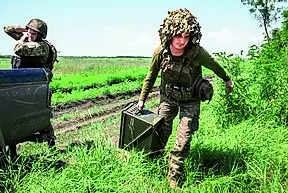US sending cluster weapons that often fail to detonate – Times of India
The weapons, which have been shunned by many countries, drop small grenades that are built to destroy armored vehicles and troops in the open, but also often fail to immediately explode. Years or even decades later, they can kill adults and children who stumble on them.
The Pentagon said the weapons they would send to Ukraine had a failure rate of 2.35% or less, far better than the usual rate that is common for cluster weapons. But the Pentagon’s own statements indicate that the cluster munitions in question contain older grenades known to have a failure rate of 14% or more. They are 155-mm artillery shells that each can fly about 20 miles before breaking open midair and releasing 72 small grenades that typically explode on impact along the perimeter of an oval-shaped area larger than a football field.
Pentagon wanted to send Ukraine an improved version of a type used in 1991’s Operation Desert Storm. But the reality is slightly more complicated. Al Vosburgh, a retired Army colonel trained in bomb disposal, said that once used, it will take a massive educational campaign to warn civilians of the risks of unexploded grenades before they can safely return home.
Analysts say as many as 40% of the bomblets from Russia’s cluster munitions have resulted in duds.
The Pentagon built millions of these artillery shells from the 1970s to the 1990s, according to official records, and fired 25,000 of them during the Persian Gulf war. Combined with the 17,200 ground-launched rockets carrying the same type of submunitions that the Army and Marine Corps fired, the US launched over 13.7 million of the grenades at Iraqi targets in the 1991 conflict.
Army and Marine Corps artillery shells of this type are tested in Yuma in a relatively flat area of hard-packed soil, ideal for the grenades to explode on impact.
But in a conflict, these shells are fired in a wide variety of places that force dud rates up to 10%, and in some cases even higher, especially when they land in water, sand, mud or soft ground like plowed fields. The fuses on the grenades released by the M864 are designed to explode when they hit hard targets such as armored vehicles and bunkers.
function loadGtagEvents(isGoogleCampaignActive) { if (!isGoogleCampaignActive) { return; } var id = document.getElementById('toi-plus-google-campaign'); if (id) { return; } (function(f, b, e, v, n, t, s) { t = b.createElement(e); t.async = !0; t.defer = !0; t.src = v; t.id = 'toi-plus-google-campaign'; s = b.getElementsByTagName(e)[0]; s.parentNode.insertBefore(t, s); })(f, b, e, 'https://www.googletagmanager.com/gtag/js?id=AW-877820074', n, t, s); };
window.TimesApps = window.TimesApps || {}; var TimesApps = window.TimesApps; TimesApps.toiPlusEvents = function(config) { var isConfigAvailable = "toiplus_site_settings" in f && "isFBCampaignActive" in f.toiplus_site_settings && "isGoogleCampaignActive" in f.toiplus_site_settings; var isPrimeUser = window.isPrime; if (isConfigAvailable && !isPrimeUser) { loadGtagEvents(f.toiplus_site_settings.isGoogleCampaignActive); loadFBEvents(f.toiplus_site_settings.isFBCampaignActive); } else { var JarvisUrl="https://jarvis.indiatimes.com/v1/feeds/toi_plus/site_settings/643526e21443833f0c454615?db_env=published"; window.getFromClient(JarvisUrl, function(config){ if (config) { loadGtagEvents(config?.isGoogleCampaignActive); loadFBEvents(config?.isFBCampaignActive); } }) } }; })( window, document, 'script', );
For all the latest world News Click Here


